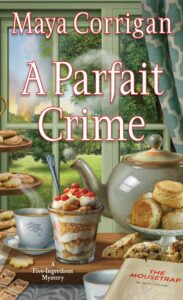On the day Agatha Christie died in 1976, London theaters dimmed their lights for an hour in a show of esteem for her. While best known as the top-selling novelist of all time, Christie also set a record for the longest running stage production. The play she predicted would last 8 months, The Mousetrap, opened in 1952 and is now starting its 8th decade on the London stage. It’s also a staple of school and community theaters, like the one in my latest book, A Parfait Crime, which centers on rehearsals for The Mousetrap. Neither my book nor this article reveals the culprit in Christie’s play. The focus here is not on whodunit but on how-she-dunit, how Christie wrote a play that has thrilled audiences over many years.
The play’s setting is a snowbound country guesthouse, where the lodgers and owners are trapped with a murderer in their midst. This scenario echoes the setup in Christie’s most famous mysteries, including some that she adapted for the theater. The Mousetrap differs from her book adaptations in its source and its underlying crime “ripped from the headlines.” That combination results in drama that packs an emotional punch unlike any other by Christie.
From 1943 to 1960 she adapted six of her novels for the theater. The most successful was based on the book now called And Then There Were None. With a more upbeat ending than the book, the play was popular, running 260 performances in London and 425 in New York. Yet the press gave it mixed reviews. The New York Times criticized its “talkativeness” and its insufficient explanation for the crimes. Christie’s other book adaptations had brief runs in London, but no critical acclaim. An intricate 200-page detective novel does not translate easily into a two-hour show. Her most successful plays were not based on full-length books. Witness for the Prosecution was adapted from a short story she’d written decades earlier. The Mousetrap originated as a short play.
In the late 1940s Christie received an offer she couldn’t refuse—a commission from the British royal family to write a radio play. Queen Mary, grandmother of Queen Elizabeth II, had requested a new Christie play as a gift for her 80th birthday. Christie’s half-hour play, Three Blind Mice, broadcast in May 1947, was the basis for The Mousetrap. Christie incorporated the audio elements needed for a radio play into her theater version. Sound effects and music combine with stage lighting, or the lack of it, to evoke dread in the audience akin to what the cast on stage experiences.
In Christie’s other plays the curtain goes up on a tastefully furnished drawing room, hotel lounge, or lawyer’s office. We are in the realm of the well-to-do. The dialogue introduces the characters and the occasion for their gathering in which death intrudes. The Mousetrap has a more riveting opening. Before the curtain goes up, the house lights dim and then turn off. The audience sits in total darkness as the music of “Three Blind Mice” plays. The curtain then rises on an unlit stage. The music fades, replaced by eerie whistling of the same tune, followed by screams, shouts, and police whistles.
The stage lights go up, revealing an empty sitting room with old-fashioned, shabby furniture. The newly painted sign near an archway tells us this is a manor converted to a guesthouse. A voice on a staticky radio announces the murder of a woman in London and describes a man seen in the vicinity of the crime. As the radio broadcast warns of heavy snow and icy roads, a young woman comes on stage. Before any character in the play says a word, a Christie-savvy audience assumes the London murderer will take refuge from the storm in the guesthouse.
When I saw The Mousetrap in London, that opener with its sounds of violence left my nerves taut and my heart racing. The stillness in the dark theater suggested that others in the audience were similarly affected. The “Three Blind Mice” leitmotif recurs at intervals during the play. We learn that someone whistled that tune just before the London murder occurred. Later in the play the same whistling heralds another murder. The stage goes black once more and we hear the victim’s struggles as the murder is committed. With no clues to figure out who the murderer is, the characters are on edge. So is the audience. We wait for the killer to strike for a third time and wonder who the next victim will be.
Anxiety isn’t the only feeling the audience and characters have. Christie’s humorous lines provide relief from the tension. The guesthouse owners arouse our empathy as they struggle to make a living in post-war England amid food and fuel rationing that lasted into the 1950s. A heart-wrenching true crime, heavily covered in the news, inspired Christie’s plot and motivates the murderer in The Mousetrap. Though today’s audiences are not familiar with that specific crime, similar ones appear in our newspapers with depressing regularity. Like audiences 70 years ago, we are outraged by the criminal acts and feel pity for the victims. Before the play ends, Christie even manages to evoke sympathy for the murderer.
The Mousetrap doesn’t present us with a puzzle to solve, but with a human tragedy. It’s Christie’s most enduring play because it does what theater is meant to do: engage our emotions, not just our little gray cells.
The crime behind the murders in my latest Five-Ingredient Mystery differs from the one in Christie’s play, but both cast long shadows. In A Parfait Crime café manager Val joins her grandfather in rehearsing The Mousetrap, replacing cast member Jane, who died in an arson fire. After the skeletal remains of a man are found in Jane’s freezer, the amateur actors who know her best clam up, but one of them hints that a new upscale spa is the key to her death. When Val and Granddad go undercover at the spa, they learn that Jane wasn’t the only one with a skeleton in the cooler. While the deaths in The Mousetrap are clearly murders, the culprit in A Parfait Crime commits perfect crimes, leaving no trace behind. The police can’t find any compelling evidence of foul play. Enter the amateur sleuths to uncover the truth.
***


















